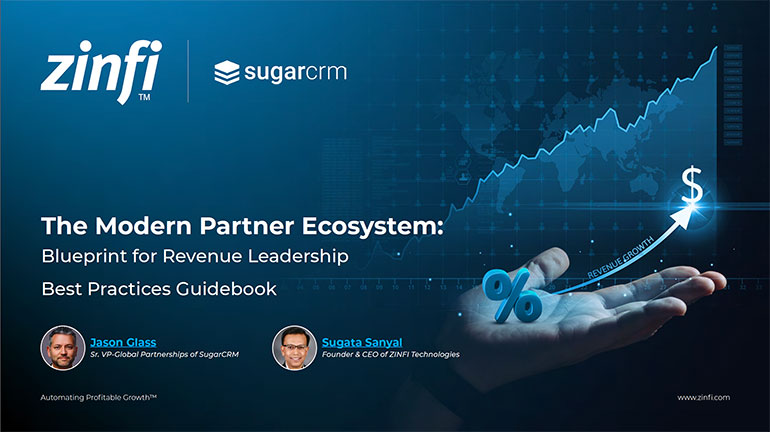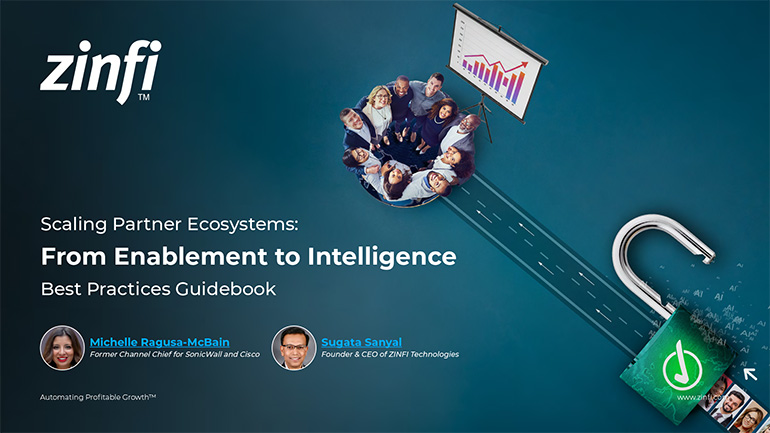Best Practices Articles

Navigating the Future: Partner Relationship Management Trends for 2024
Table of Contents
- Recap of 2023 Trends in Partner Relationship Management
- Inflation and Interest Rates
- AI Integration in PRM
- Geopolitical Shifts and PRM in 2024
- Glocalization and Supply Chains
- Presidential Election Impact
- Ozempic and Lifestyle Changes
- Hyper-Scaler Marketplaces
- PRM Maturity and Evolution
- Visibility Rules
- Control is King & Queen
As we approach the end of another eventful year, the business landscape is again on the cusp of transformation, especially in Partner Relationship Management (PRM). The dawn of 2024 beckons with a promise of new challenges and opportunities, making it an ideal time for reflection and forward-thinking. The past year has been a testament to the dynamic nature of PRM, with various predictions unfolding in unexpected ways, providing us with valuable lessons and insights. This retrospective view is not just a mere reflection but a crucial stepping stone that enables us to forecast the future of Partner Relationship Management (PRM) with greater accuracy and understanding.
In this comprehensive exploration, we are set to delve deep into the significant global and American trends poised to redefine the contours of PRM in 2024. This journey through the upcoming trends is not just an academic exercise but a practical guide filled with insights and predictions tailored for businesses and professionals navigating the complex world of partner relationships. As the global economic and political landscapes evolve, so does the approach to managing and nurturing partner relationships. The upcoming year promises to bring forth technological advancements, economic shifts, and geopolitical dynamics, which will profoundly impact how organizations manage their partnerships.
Our focus will extend beyond the mere identification of these trends. We aim to provide a nuanced understanding of how each trend could reshape the strategies and operations in partner relationship management. From the influence of emerging technologies like AI and machine learning to the impact of macroeconomic factors such as inflation and interest rates, each aspect will be scrutinized to understand its implications for PRM. Additionally, we will explore how geopolitical shifts and changing global dynamics will likely affect cross-border partnerships and international collaboration strategies.

Moreover, this article will serve as a strategic tool for businesses and PRM professionals. It will offer actionable insights and foresight, enabling them to not only brace for the changes but also to leverage these trends to their advantage. By staying ahead of these developments, businesses can capitalize on new opportunities, overcome challenges, and forge more robust, effective partner relationships. Read more.
As we embark on this insightful journey into the future of Partner Relationship Management in 2024, the ability to adapt, innovate, and strategize will be vital to thriving in this ever-evolving landscape. This article will equip you with the knowledge and perspective needed to navigate these changes successfully and harness your partner relationships' full potential in the coming year.
Recap of 2023 Trends in Partner Relationship Management
In 2023, Partner Relationship Management (PRM) experienced significant changes driven by various economic and technological developments. The year saw the continued influence of COVID-19, the normalization of hybrid work environments, and a phenomenon called 'jobless growth.' These factors and technological innovations led to several key trends in the PRM landscape.
One of the notable trends was the rise of marketplaces. This trend indicated a shift in how businesses approach partner ecosystems, with an increasing focus on leveraging online platforms for partner engagement and management. These marketplaces facilitated more accessible access to resources, streamlined communication, and provided new opportunities for collaboration, significantly impacting the dynamics of partner relationships.
Another trend was the evolving nature of partner ecosystems themselves. As businesses adapted to the changing economic and technological environment, their approach to managing partner relationships also changed. There was a greater emphasis on creating more integrated and collaborative ecosystems, which allowed for more efficient and effective partnerships.
Rewarding partner loyalty emerged as a critical focus area. Businesses recognized the importance of nurturing long-term relationships with their partners by implementing strategies to reward loyalty, and companies aimed to foster more robust, more committed partnerships. This approach helped retain valuable partners and attract new ones as businesses sought to create a more supportive and rewarding ecosystem for their partners.
This year, we also witnessed an explosion of independent software. This trend was characterized by a surge in developing and adopting specialized software solutions designed to enhance various aspects of PRM. These tools offered functionalities ranging from partner recruitment and onboarding to performance tracking and engagement analytics, thereby improving the efficiency and effectiveness of partner management processes.
Finally, there was a shift from partner-fed to partner-led activities. This change indicated a move towards giving partners more autonomy and leadership in their activities. By empowering partners to take the lead, businesses aimed to foster a more proactive and engaged partner base, which could lead to more innovative and successful collaborations.
In summary, the Partner Relationship Management (PRM) landscape of 2023 was shaped by economic factors and technological advancements. The rise of marketplaces, evolving partner ecosystems, a focus on rewarding partner loyalty, the proliferation of independent software, and the shift towards partner-led activities were crucial trends that defined the year. These developments changed how businesses managed their partner relationships and set the stage for future innovations in the field of PRM.
Major Global Trends for 2024
1. Inflation and Interest Rates
As we venture into 2024, the economic landscape is anticipated to be shaped by a unique combination of subsiding inflation but persistently high interest rates. This scenario is expected to instill a sense of caution among CEOs and business leaders, particularly in their investment decisions. This caution will likely herald a phase of 'Great Rationalization' in IT and partner management, where the focus will be streamlining operations and reducing costs through unified automation solutions. This trend is poised to go beyond cost-saving; it's about strategically optimizing and unifying technologies to forge more efficient and effective partner relationships.

The influence of high interest rates on Partner Relationship Management (PRM) is expected to be complex and multifaceted. On one hand, companies are likely to become more strategic and selective in their partnerships and investments. The era of indiscriminate spending and partnerships might give way to a more measured approach, where value, alignment with core business objectives, and potential ROI become the guiding principles. This shift could lead to a more focused and efficient PRM strategy, prioritizing quality and depth of partnerships over quantity.
On the other hand, the high-interest rate environment is anticipated to drive innovation within the Partner Relationship Management space. As traditional methods of managing partner relationships become financially challenging, businesses are expected to seek more cost-effective and efficient ways to manage and nurture these relationships. This could lead to increased adoption of advanced partner relationship management platforms that leverage automation, AI, and analytics to provide deeper insights into partner performance and engagement. These technologies could enable companies to make more informed decisions about their partnerships, optimizing resources and maximizing outcomes.
Moreover, the high-interest rate scenario in 2024 will likely encourage companies to explore new partnership models and revenue-sharing agreements that are more financially sustainable and risk-averse. Businesses might lean towards partnerships that offer mutual benefits with shared risks, especially when upfront investments are significant.
In summary, the expected economic conditions of 2024, characterized by high-interest rates, will likely reshape the partner relationship management approach. Companies must navigate this landscape with a more strategic, data-driven, cost-effective approach to managing partner relationships. This leads to a more resilient and agile PRM strategy facing economic uncertainties.
2. AI Integration in PRM
As we look towards 2024, the integration of Artificial Intelligence (AI) in Partner Relationship Management (PRM) is poised to transform the landscape of organizational strategies and execution. AI is expected to evolve beyond its current role of automating tasks, becoming pivotal in reshaping how companies interact with and manage their partners. This transformation will likely lead to more intelligent organizations, where key outcomes are enhanced collaboration and significant waste reduction. Read more.
In 2024, AI-driven insights could enable companies to make more informed decisions, prioritize tasks, and execute strategies with greater efficacy locally and globally. The potential of AI to analyze vast amounts of data and extract meaningful insights will likely be instrumental in identifying patterns and opportunities that were previously unnoticed. This capability could lead to more strategic and targeted approaches in partner management, allowing companies to tailor their strategies to each partnership's unique needs and potential.
The future of AI in Partner Relationship Management also suggests a significant shift towards predictive analytics. By analyzing historical data and current market trends, AI could provide companies with foresight into future market developments, partner behaviors, and potential challenges. This predictive power might enable businesses to proactively adjust their strategies, staying ahead of the curve in a dynamic market environment.

Furthermore, AI could revolutionize the personalization aspect of PRM. AI might offer highly personalized communication and engagement strategies by understanding partner preferences, behaviors, and interactions through advanced machine learning algorithms. This level of customization could enhance partner satisfaction and loyalty, leading to more robust, productive relationships.
Another potential development in 2024 could be the use of AI in automating complex decision-making processes within Partner Relationship Management (PRM). From resource allocation to conflict resolution, AI might take on more sophisticated roles, offering recommendations based on a comprehensive analysis of available data. This advancement could streamline decision-making processes, reduce the cognitive load on human managers, and lead to more efficient and effective management of partner relationships.
In conclusion, integrating AI in PRM in 2024 could mark a significant turning point in how businesses manage and nurture their partner relationships. By leveraging AI-driven insights and capabilities, companies might find themselves responding to and actively shaping the market, leading to a more dynamic, responsive, and successful approach to partner management.
3. Geopolitical Shifts and PRM in 2024
As we look towards 2024, the geopolitical landscape will continue shifting towards a multi-polar world, which will have significant implications for Partner Relationship Management (PRM). The evolving dynamics among major power centers such as the United States, China, the European Union, and India will likely create a complex and challenging business environment. This shift could lead to increased nationalistic tensions and a rise in populism, influencing trade policies and, consequently, partner relationships on a global scale.
In 2024, businesses engaged in Partner Relationship Management will likely need to navigate a landscape where geopolitical alignments and misalignments are more pronounced. Trade policies may become tools of geopolitical strategy, affecting how and with whom companies can do business. This environment could see the emergence of new trade blocs or the strengthening of existing ones, compelling companies to reassess their global partner networks.
Moreover, rising nationalistic sentiments could lead to more protectionist policies, impacting global supply chains and partner relationships. Companies might adjust their PRM strategies to align with these new policies, potentially reshaping their global footprint. This could involve forming new partnerships in politically stable regions or re-evaluating existing relationships in areas with high geopolitical tensions.
In addition to traditional trade conflicts, 2024 might witness increased cyber and kinetic confrontations. These conflicts could directly impact businesses, particularly in sectors like technology and telecommunications, where cybersecurity and data sovereignty are paramount. Companies must ensure their PRM strategies are robust enough to withstand such challenges, incorporating risk assessments and contingency planning for geopolitical events.
Furthermore, different regions' varying political and economic landscapes will require a more nuanced approach to partner relationship management. Businesses will need to be adaptable, tailoring their strategies to the specific conditions of each market. This could involve leveraging local insights to navigate complex political environments or adopting flexible systems that respond quickly to sudden geopolitical shifts.

In summary, 2024 is poised to be a year where geopolitical considerations play a critical role in PRM. Businesses must be vigilant, adaptable, and strategically savvy to navigate this multi-polar world successfully. By understanding and responding to these geopolitical nuances, companies can maintain strong and resilient partner relationships, even in the face of global uncertainties.
4. Glocalization and Supply Chains
In 2024, the concept of glocalization – the fusion of global and local considerations – is expected to play a pivotal role in the evolution of Partner Relationship Management (PRM). As businesses navigate the complexities of a globalized world, the need for rationalization in investments, particularly in the wake of advancements in AI, will likely impact global supply chains significantly. This impact will be further compounded by ongoing geopolitical conflicts, which are anticipated to introduce new challenges and opportunities in supply chain management.
One of the key trends that could emerge in 2024 is the increased inefficiency in certain parts of the global supply chain due to geopolitical tensions. This situation will likely prompt businesses to adopt near-shoring and friend-shoring strategies more aggressively. Near-shoring involves moving business operations closer to home, while friend-shoring refers to doing business with countries with similar values and political alignments. These strategies could become essential for companies looking to mitigate the risks associated with global supply chain disruptions.
As a result, companies are expected to reevaluate their global strategies, emphasizing localizing their operations and partner relationships. This shift towards glocalization in partner relationship management is not merely about managing supply chain risks; it's about building more resilient and responsive strategies that adapt to the rapidly changing global dynamics. Companies might start focusing on developing stronger local partnerships and investing in local markets, which can offer more stability and quicker responsiveness to changing market conditions.
Moreover, integrating AI in supply chain management will likely play a crucial role in enhancing the efficiency of these localized strategies. AI-driven tools could provide businesses with advanced analytics and insights, enabling them to make more informed decisions about their local and global operations. This technology could help companies identify the most effective ways to integrate local and international strategies, ensuring they can respond swiftly and effectively to any challenges.

In conclusion, the trend of glocalization in 2024 is expected to influence Partner Relationship Management strategies significantly. Companies will likely find themselves balancing global aspirations with local realities, leveraging technology like AI to navigate this complex landscape. This approach will help manage supply chain risks and create more adaptable, resilient, and responsive PRM strategies.
Major American Trends for 2024
5. Presidential Election Impact
As we look toward the 2024 presidential election, the potential of a Biden vs. Trump rematch introduces a significant level of unpredictability into the American business landscape, including the realm of Partner Relationship Management (PRM). The political climate profoundly influences business environments, regulatory frameworks, and international relations, crucial factors in how companies manage and interact with their partners. The outcome of this election could be pivotal in determining the direction of trade policies, international collaborations, and broader economic strategies, making it a critical element for PRM strategists to monitor closely.
In the future tense, considering the possibilities of 2024, businesses might find themselves navigating a landscape where regulatory changes could occur rapidly, depending on the election's outcome. If Biden were to win, we could anticipate a continuation or even an intensification of current policies, potentially focusing on strengthening international alliances and trade agreements. This scenario could foster a more stable and predictable environment for international partnerships, encouraging businesses to expand their global Partner Relationship Management strategies.
Conversely, a Trump victory could signal a shift towards more nationalistic policies, as seen during his previous tenure. This might lead to renegotiations of trade agreements and a potential tariff increase, impacting international supply chains and partner relationships. Companies might need to pivot towards more localized strategies, strengthening domestic partnerships while navigating the complexities of an altered global trade landscape.

Regardless of the election's outcome, businesses will likely prioritize building flexibility into their partner relationship management plans in 2024. This approach would allow them to adapt to the changing political landscape quickly. For instance, companies might invest in agile PRM systems that respond promptly to changes in tariffs, regulatory environments, and market conditions.
Moreover, the election could also impact consumer sentiment and spending, influencing market trends and partner dynamics. Businesses might need to adjust their marketing and sales strategies in response to these shifts, requiring a partner relationship management system that can swiftly adapt to changing consumer behaviors.
In summary, the 2024 presidential election could significantly change the PRM landscape. Businesses might need to prepare for various scenarios, emphasizing the importance of staying informed and agile in a politically dynamic environment. The ability to quickly adapt to new policies, market conditions, and consumer trends will be crucial for maintaining effective and resilient partner relationships in this uncertain political climate.
6. Ozempic and Lifestyle Changes
In 2024, the rise of Ozempic and its influence on American lifestyles is expected to continue significantly shaping the landscape of Partner Relationship Management (PRM) in the U.S. As health and wellness increasingly become focal points in people's lives, this trend is anticipated to open new avenues and reshape existing strategies in the business world, particularly in how companies manage and develop their partner relationships.
The growing consumer interest in health and wellness is not a transient phenomenon but a deep-rooted shift in lifestyle choices. This change will likely persist and evolve, influencing consumer behavior on a large scale. As a result, businesses are projected to explore and establish more partnerships in the health and wellness sectors. These partnerships could range from collaborations with fitness and wellness brands to alliances with healthcare providers and pharmaceutical companies.

In 2024, companies might also intensify their focus on health-conscious marketing and customer engagement strategies. This shift could manifest in various forms, such as promoting products and services that align with a healthier lifestyle or adopting marketing narratives that emphasize well-being and health consciousness. Integrating health-focused values into brand messaging and partner strategies is expected to resonate strongly with a consumer base that is increasingly attentive to health and wellness.
Furthermore, the influence of Ozempic and similar trends could significantly transform the types of products and services companies offer. There might be an upsurge in demand for health-related products, leading to a diversification of offerings in the market. This diversification could, in turn, necessitate a reevaluation and adaptation of PRM strategies to cater to these emerging market segments effectively.
Additionally, the health and wellness trend is likely to impact the internal dynamics of companies as well. Employee wellness programs and health-focused organizational initiatives could become more prevalent, reflecting the broader societal shift toward health consciousness. This internal focus on health and wellness could enhance employee satisfaction and productivity, benefiting the company's overall performance and partner relationships.
In conclusion, the ongoing trend towards health and wellness, exemplified by the rise of Ozempic, is poised to impact PRM strategies in 2024 substantially. Companies that successfully align their partner relationships and business strategies with this trend will likely gain a competitive edge in an increasingly health-conscious market.
Major Technology Trends in Partner Relationship Management
7. Hyper-Scaler Marketplaces
In 2024, the Partner Relationship Management (PRM) landscape is expected to be significantly influenced by the continued dominance of hyper-scaler marketplaces like Azure, AWS, and Google Cloud. However, a parallel trend poised to make a substantial impact is the rise of satellite marketplaces such as Adobe, Salesforce, Shopify, and others. These platforms are carving out specialized ecosystems, offering unique opportunities for PRM tailored to specific market niches and business needs.
The emergence and growth of these satellite marketplaces indicate a broader diversification in the PRM landscape. Businesses will likely find themselves now free of the offerings of the major players. Instead, they will have the opportunity to explore a variety of platforms that provide distinct advantages and cater to different operational facets. This trend is expected to encourage more personalized and niche-focused PRM strategies, allowing businesses to align more closely with platforms that resonate with their specific industry requirements and partnership dynamics. Please check our video podcast discussion between Sugata Sanyal, CEO of ZINFI, Jay McBain, Chief Analyst at Canalys, and Darryl Oliver, Director of Ingram Micro Cloud, where they explore the evolving landscape of hyper-scaler ecosystems and their impact on the channel. They emphasize the importance of understanding the dynamics of cloud platforms, the need for trusted advisors and partners, and the role of automation in streamlining vendor and partner engagements.
In 2024, it is anticipated that these satellite marketplaces will evolve to offer more than just alternative solutions; they will likely become breeding grounds for innovation in PRM. As these platforms grow, they will probably develop unique features and capabilities that address specific industry challenges, offering a level of specialization that the larger, more generalized media may need to provide. This could include advanced analytics tailored to particular sectors, integration capabilities with niche software and tools, and community-building features that foster more robust, more engaged partner networks.
Furthermore, the rise of these satellite marketplaces is expected to spur competition among themselves and the larger hyper-scaler platforms. This competition could lead to rapid advancements in PRM technology and practices, benefiting businesses. Companies might find themselves leveraging a mix of hyper-scaler and satellite platforms, combining the broad reach and robust infrastructure of the former with the specialized tools and community focus of the latter.
In conclusion, as we look towards 2024, the PRM landscape will likely be characterized by more decadent, diverse marketplace options. This diversity will give businesses unprecedented flexibility and choice in managing and optimizing their partner relationships, leading to more effective, efficient, and tailored PRM strategies.

8. PRM Maturity and Evolution
As we look towards 2024, the maturation and evolution of Partner Relationship Management (PRM) are set to reach new heights. This year, we anticipate a significant transformation in how PRM platforms are utilized and perceived across various business sectors. Integrating hyper-personalized workflows, advanced connectors, and sophisticated analytics will drive these platforms, marking a pivotal shift from traditional PRM approaches to more dynamic and strategic implementations.
In the mid-market segment, companies are expected to rapidly adopt PRM solutions to streamline partner experiences and reduce operational costs. This trend will likely be driven by the need for these companies to compete more effectively with larger enterprises, necessitating the adoption of technologies that enable them to operate more efficiently and scale more quickly. PRM platforms will be instrumental in achieving these goals, offering mid-market companies the tools they need to manage partner relationships more effectively and drive business growth.
For large enterprises, 2024 is poised to be a year of rationalizing their existing PRM infrastructure. These organizations will likely focus on consolidating their partner relationship management tools and processes to create a more unified and streamlined approach. This rationalization will involve integrating disparate systems and data sources into a cohesive platform, enabling these enterprises to gain a more comprehensive view of their partner ecosystems. The goal will be to create a more efficient, data-driven approach to managing partner relationships, reducing complexity, and improving decision-making.

The evolution of PRM platforms will also see a greater emphasis on creating seamless, intuitive experiences for partners. Companies will strive to make their PRM interfaces as user-friendly as possible, reducing the learning curve and making it easier for partners to engage and collaborate. This focus on user experience is not just about aesthetics; it's about making the business process as smooth and frictionless as possible, fostering more robust and productive partnerships.
Moreover, the strategic use of Partner Relationship Management platforms will become more pronounced. Companies will leverage these tools for operational efficiency and as a critical component of their growth and expansion strategies. By providing deep insights into partner performance, preferences, and potential areas for collaboration, PRM platforms will enable companies to identify new growth opportunities and strategically align their resources to capitalize on them.
In summary, 2024 is expected to be a transformative year for PRM, with platforms evolving to become more sophisticated, intuitive, and strategic. This evolution will enable companies of all sizes to manage their partner relationships more effectively, driving growth and success in an increasingly competitive business landscape.
9. Visibility Rules
In 2024, the emphasis on visibility within Partner Relationship Management (PRM) is expected to reach new heights, becoming a pivotal focus for mid- and enterprise-level companies. This year, businesses will likely invest heavily in tools and strategies that provide real-time insights into partner journeys, performances, and experiences. The trend goes beyond merely tracking metrics; it's anticipated to evolve into a comprehensive approach for understanding and enhancing the partner experience.
The future of PRM in 2024 will likely see an increased adoption of advanced analytics and AI-driven tools. These technologies will provide more profound, nuanced insights into partner behaviors, preferences, and interactions. By leveraging data analytics, companies could predict partner needs and preferences, enabling them to tailor their approaches and offerings effectively. This predictive capability is not just about responding to current trends but anticipating future partner needs, thereby staying ahead in the partnership game. Download the best practices guidebook.

Real-time visibility is set to play a crucial role in 2024. With the integration of IoT (Internet of Things) and other real-time data-gathering tools, companies could monitor partner interactions and performances as they happen. This immediate insight allows swift responses to any issues or opportunities, making PRM more dynamic and responsive. For instance, if a partner's performance drops, the system could immediately flag this, allowing managers to intervene promptly and address any underlying issues.
Furthermore, time-shifted collaboration models are expected to gain traction. These models allow for asynchronous communication and collaboration, which is particularly beneficial for global partnerships spanning multiple time zones. By combining real-time and time-shifted models, companies could create a more flexible and inclusive PRM environment, accommodating different working styles and schedules.
In addition, visibility in 2024 will likely extend beyond operational metrics to include more qualitative aspects of partner relationships, such as satisfaction and engagement levels. Advanced sentiment analysis tools could be employed to gauge these relationships' health, providing insights beyond numbers and figures.
In conclusion, enhanced visibility in Partner Relationship Management will transform how companies manage and interact with their partners in 2024. By investing in the right tools and strategies, businesses could better understand their partners, leading to more effective engagement, collaboration, and, ultimately, stronger and more productive partnerships.
10. Control is King & Queen
In 2024, the mantra for Partner Relationship Management (PRM) businesses will be achieving growth at a lower cost. Companies will actively seek innovative ways to expand and grow their partner networks without incurring excessive costs. This imperative will lead to more strategic and targeted PRM approaches, focusing on high-value activities and partnerships that offer the best return on investment.
In this evolving landscape, control will be about managing resources, making informed decisions, and maintaining a strategic focus. Companies will be leveraging data analytics and AI-driven insights to make smarter decisions about where to allocate resources for maximum impact. The emphasis will be on optimizing existing resources and extracting the most value from each partnership.

In 2024, companies will likely adopt a more holistic approach to PRM. This approach will involve carefully assessing the entire partner lifecycle, from recruitment and onboarding to management and growth. By understanding and optimizing each stage of this lifecycle, companies can ensure that they attract the right partners and maximize the potential of these relationships.
Moreover, sustainability will be a crucial consideration in PRM strategies. Companies will be looking to build partnerships that are not only profitable but also sustainable in the long term. This means focusing on partners who share similar values and goals and are committed to a mutually beneficial relationship. The focus will be on creating a stable and resilient partner network that can withstand market fluctuations and other external challenges.
Additionally, companies will be exploring new models of collaboration and partnership. This could include joint ventures, strategic alliances, and other forms of cooperation that allow companies to share resources, expertise, and risks. By pooling resources and working collaboratively, companies can achieve a grander scale and impact than they could alone.
In conclusion, 2024 will be a year where control in Partner Relationship Management becomes paramount. Companies will be looking to grow their partner networks in a way that is both cost-effective and sustainable. Companies can succeed by focusing on high-value partnerships, optimizing resources, and exploring new collaboration models while maintaining control over their PRM strategies.
Conclusion
As the horizon of 2024 approaches, it becomes increasingly evident that the landscape of Partner Relationship Management (PRM) is on the brink of an exciting evolution. The trends we have discussed are not mere speculations but emerging realities shaping how organizations manage and nurture their partner relationships. Understanding and adapting to these changes will be advantageous and essential for businesses striving to maintain robust and effective partner relationships in this dynamic and ever-changing environment.
The upcoming year promises to be a period of both opportunities and challenges. Integrating advanced technologies like AI, the impact of global economic shifts such as inflation and interest rates, and the complexities of a multi-polar geopolitical landscape will all play a crucial role in redefining PRM strategies. Organizations that proactively recognize and respond to these trends will be better positioned to leverage new opportunities. They will be able to harness the power of data-driven insights, optimize their operations in line with global economic conditions, and navigate the intricacies of international partnerships with more remarkable finesse.

Moreover, the evolving PRM landscape is not just about responding to external changes but also about internal transformation. Companies must cultivate a culture of agility and continuous learning to keep pace with these developments. This involves investing in the right technologies and strategies and the people who drive these initiatives. Empowering teams with the knowledge and tools to adapt to these changes will be vital to building a resilient and forward-thinking PRM strategy.
The future of Partner Relationship Management, as we step into 2024, is indeed dynamic and exciting. It promises more sophisticated, efficient, and impactful partner management practices. Those organizations that are prepared to embrace and navigate these changes will survive and thrive. They will lead the charge, set new standards, and reap the benefits of a more connected, intelligent, and strategic approach to partner relationship management. As we progress, the mantra for success in PRM will be adaptability, foresight, and a relentless pursuit of innovation.
For more information, please check this article.


Best Practices Guidebook
 Unified Communications: The Backbone of Modern Digital Growth
Unified Communications: The Backbone of Modern Digital GrowthDownload for FREE
 The Channel Sales Playbook: Skills, Strategy, and Growth
The Channel Sales Playbook: Skills, Strategy, and GrowthDownload for FREE
 Blueprints for Vertical Success Best Practices
Blueprints for Vertical Success Best PracticesDownload for FREE
 The Future of Partner Enablement: From Enablement Gaps to Global Advantage
The Future of Partner Enablement: From Enablement Gaps to Global AdvantageDownload for FREE
 Reimagine Sales Development. Build a Smarter Prospecting Engine
Reimagine Sales Development. Build a Smarter Prospecting EngineDownload for FREE
 The Zero Trust Imperative: Fortifying Enterprise Security Against AI-Driven Threats
The Zero Trust Imperative: Fortifying Enterprise Security Against AI-Driven ThreatsDownload for FREE
 PartnerOps Excellence: The Definitive Guide to Scalable SaaS Ecosystems
PartnerOps Excellence: The Definitive Guide to Scalable SaaS EcosystemsDownload for FREE
 The Modern Partner Ecosystem Best Practices
The Modern Partner Ecosystem Best PracticesDownload for FREE
 Partner Marketing Reimagined: Strategies for Agile, Insight-Led Growth
Partner Marketing Reimagined: Strategies for Agile, Insight-Led GrowthDownload for FREE
 Scaling with PartnerOps Best Pratices
Scaling with PartnerOps Best PraticesDownload for FREE
 Leading with Partner Programs Best Pratices
Leading with Partner Programs Best PraticesDownload for FREE
 The Partner-First Blueprint: Scaling Trust, Intelligence, and Ecosystem Growth
The Partner-First Blueprint: Scaling Trust, Intelligence, and Ecosystem GrowthDownload for FREE
 Unlock Scalable Growth with The Partner Marketing Growth Blueprint
Unlock Scalable Growth with The Partner Marketing Growth BlueprintDownload for FREE
 From TikTok to LinkedIn: Social Selling Across the Generational Divide
From TikTok to LinkedIn: Social Selling Across the Generational DivideDownload for FREE
 Scaling Partner Ecosystems: From Enablement to Intelligence
Scaling Partner Ecosystems: From Enablement to IntelligenceDownload for FREE
 The Ultimate Guide to Partner Marketing Success Best Practices
The Ultimate Guide to Partner Marketing Success Best PracticesDownload for FREE
 How to Start and Scale Partner Ecosystems Best Practices
How to Start and Scale Partner Ecosystems Best PracticesDownload for FREE







